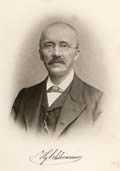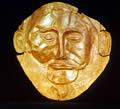Heinrich Schliemann archaeologist
Archaeology of Troy
 Heinrich Schliemann (Johann Ludwig Heinrich Julius Schliemann) was born in January 1822 in the German territory of
Mecklenburg-Schwerin. His father was a minister of religion and the family, which grew to include several children,
was not too prosperous by all accounts. Indeed, the demise of Heinrich Schliemann's mother in 1831 was followed by
Heinrich's being sent to live with an uncle although a brief period of education at a Gymnasium (grammar school),
was funded by his father.
Heinrich Schliemann (Johann Ludwig Heinrich Julius Schliemann) was born in January 1822 in the German territory of
Mecklenburg-Schwerin. His father was a minister of religion and the family, which grew to include several children,
was not too prosperous by all accounts. Indeed, the demise of Heinrich Schliemann's mother in 1831 was followed by
Heinrich's being sent to live with an uncle although a brief period of education at a Gymnasium (grammar school),
was funded by his father.During his time at the Gymnasium Heinrich Schliemann was not yet a teenager but he may have already developed an interest in Archaeolgy. In later life Schliemann claimed that his father had already introduced him to tales of the Greek Classical Era as related in The Iliad and The Odyssey, and had given him an Illustrated History of the World as a christmas gift in 1829.
Heinrich Schliemann even claimed in later life that by the age of eight he had already formed the ambition to excavate the ancient city of Troy. Schliemann also related how he and a young playmate, a girl named Minna Meincke, used to conduct "archaeological excavations" at the local churchyard and would spend time in the ruins of a local castle.
It happened that Schliemann senior was accused of embezzleing church funds and the ensuing scandal and loss of income contributed to his sons presence in the Gymnasium being only a brief one. Despite having a real interest in the Greek language, and a scholarly cast of mind, Heinrich spend a few years in a trades and commerce related 'vocational school' before becoming a apprenticed to a grocer at the age of fourteen.
Heinrich stayed in this employment for some five years but continued to read in line with his interests in his limited spare time. He later claimed to have taught himself Dutch, English, French, Spanish, Italian, and Portuguese, over some two years. In 1841 Heinrich abruptly left his employer and embarked as a cabin boy on a ship bound for South America but a shipwreck saw him being returned to German territory after a rescue and landing in the Netherlands.
He subsequently gained employment in merchant trading enterprises and was sent by one such firm to the Russian city of St Petersburg where his talent for and interest in languages allowed him to learn Russian and Greek in order readily converse with his clients and other business contacts.
Schliemann seems to have employed a system that he used his entire life to learn languages - that of writing up his diary in the language of whatever country he happened to be in.
Circa 1851 Heinrich moved to California where one of his brothers had made a fortune during these years which were years of "Gold Rush." Heinrich started a banking enterprise that bought and sold the gold dust won by the miners. Although he seems to have made a lot of money, (his bank seems to have handled $1,350,000 worth of gold in just six months), Heinrich Schliemann returned to Russia in 1852.
Back in Russia Heinrich set himself up on somewhat gentlemanly patterns of life and married Ekaterina Lyschin, a niece of one of his wealthy friends.
The new Mrs. Heinrich Schliemann seems to have expected Heinrich, although already quite wealthy, to continue to be prosperously active in business. Involvements in commerce as a contractor of military supplies at the time of the Crimean War (1854-1856) brought yet more wealth to the Schliemann household. This level of wealth allowed Heinrich Schliemann to retire from being an active merchant and to actively pursue his deep interest in the world of the ancient civilisations of Greece and Troy. He based himself in Paris and unsuccessfully tried to encourage his wife to bring their three children to continue their lives there.
In 1868, after several years of archaeological exploration principally undertaken in Turkey, Heinrich Schliemann took on a partnership interest in a site at Hissarlik, previously investigated by a British Archaeolgist named Frank Calvert, that Schliemann himself was convinced was the site of the ancient city of Troy. Schliemann by this time seems to have become firmly committed to finding the site of Troy and to decisively proving the actual historicity of the "Trojan War" as related in the ancient greek classics.
It happened that there was a falling out between Heinrich Schliemann and Frank Calvert as Schliemann, then an enthusiastic but perhaps unscientific excavator, assuming that "Homeric" Troy must be at the lower levels of the remains of the settlement appears to have dug straight down to those levels without, in Calvert's view, sufficiently investigating the materials removed.
Ancient fortifications were discovered, however, in 1872. A cache of artefacts in copper, silver and gold was enearthed in 1873 and styled by Heinrich Schliemann as being "Priam's Treasure" after King Priam of Troy.
By this time Heinrich Schliemann and his first wife, (who was not interested in Archaeology), had parted company, Schliemann had asked a friend to help him find a well-educated, Greek woman, who was beautiful, dark-haired, poor, and shared a great interest in Homer. Schliemann's new younger wife appeared wearing the so-styled "Jewels of Helen."
(Two children were born to this second marriage. These two, male, children were given the names Andromache and Agamemnon Schliemann).
In the event the Turkish government disapproved of Heinrich Schliemann's approach to publicising his discoveries and revoked permissions to excavate at Hissarlik. Schliemann and Calvert further alienated the Turkish authorities by smuggling the so-called "Priam's Treasure" out of Turkey.
 Scliemann subsequently embarked on excavations on the island of Crete where, in 1876, he enearthed elaborate
golden artefacts,
including a so styled "Mask of Agamemnon" discovered alongside skeletal remains in shaft graves associated by Schliemann
with the ancient civilisation of the Myceneans.
Scliemann subsequently embarked on excavations on the island of Crete where, in 1876, he enearthed elaborate
golden artefacts,
including a so styled "Mask of Agamemnon" discovered alongside skeletal remains in shaft graves associated by Schliemann
with the ancient civilisation of the Myceneans.
The Turkish authorities had agreed to allow Schliemann to resume excavations at Hissarlik / Troy in 1876 but Schliemann did not return there to dig until a "second excavation" of 1878-1879. Other excavations followed in 1882-1883 and 1888-1890. During these later periods Heinrich Schilemann was assisted by other archaeologists including Wilhelm Dörpfeld, (in 1888-1890), who taught him to stratigrapize.
Heinrich Schliemann developed a serious infection in his ears and after an operation in Greece in November 1890. Against the advice of his doctors he subsequently traveled to Leipzig, Berlin and Paris but medical complications associated with his initial ear complaint set in. He was on his way back to Athens for christmas of that year but came to rest in Naples too unwell to complete the journey.
He did visit the ruins of Pompeii but collapsed on Christmas day and died the following day.
His friends ensured that he was buried in Greece in an elaborate mausoleum that Schliemann had already had built upon an Athenian hill and in the ancient Greek style as his final resting place. An inscription in ancient greek above the entrance to this mausoleum declared it to be "For the hero, Schliemann."
Heinrich Schliemann remains a controversial figure often accused of manipulating the details of his own life and his "discoveries" to build a misleading picture of his career and achievements. Other sources, including early personal letters, do not seem to support his claims that he had a very serious interest from an early age in Archaeology. More seriously still a servant of long standing claimed that metal "artefacts" were manufactured at Schliemann's request such they they could be "salted" for "discovery" at ancient sites. Even the Mask of Agamemnon itself is sometimes alleged to be in this category as it seems to be in a style not known elsewhere in Greek Archaeology.
